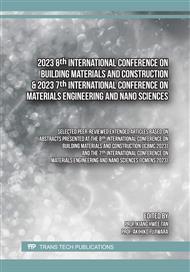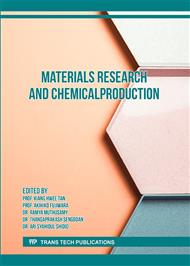p.51
p.65
p.71
p.77
p.83
p.89
p.105
p.117
p.131
Montmorillonite/Tripolyphosphate Crosslinked Chitosan Nanocomposites for Eco-Friendly Agricultural Applications
Abstract:
Natural montmorillonite (MMT) was facilely impregnated with a mixed solution of protonated chitosan (CS) and KNO3, which was then subsequently impregnated with sodium tripolyphosphate (TPP) to ionically crosslink with chitosan, resulting in the MMT/xCS-20KNO3-TPP nanocomposites. The initial content of chitosan to MMT was varied from 2.5, 5 and 10 wt%, and while the TPP:chitosan weight ratio was kept at 1:5. The K+ and NO3- ions interacted ionically and were entrapped in the MMT basal spacing and the free volume of TPP crosslinked chitosan of the MMT/xCS-20KNO3-TPP nanocomposites. These nanocomposites were able to successfully prolong the K+ and NO3- releases, in which the cumulative released values (%R) ranging from 21 – 26 % for K+ and 0.37 – 0.65 % for NO3-. The presence of protonated amine in the chitosan played the dominant effect on the release profile of NO3- ion more than that of the K+ ion. The higher the chitosan content employed in the impregnation method, the more crosslinked chitosan structure in the MMT/xCS-20KNO3-TPP nanocomposites, resulting in decreased K+ and NO3- releases at each pre-determined soaking duration. The MMT/xCS-20KNO3-TPP nanocomposites have been considered as a promising choice for environmentally friendly fertilizers.
Info:
Periodical:
Pages:
83-87
Citation:
Online since:
September 2023
Authors:
Keywords:
Price:
Сopyright:
© 2023 Trans Tech Publications Ltd. All Rights Reserved
Share:
Citation:



